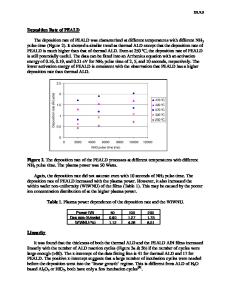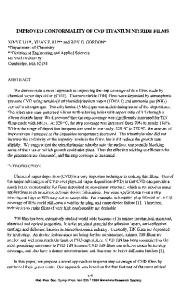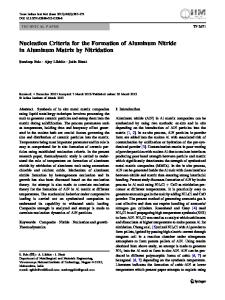Formation mechanisms and atomic configurations of nitride phases at the interface of aluminum nitride and titanium
- PDF / 693,384 Bytes
- 8 Pages / 612 x 792 pts (letter) Page_size
- 48 Downloads / 343 Views
Aluminum nitride was bonded with a titanium foil at 1400 °C for up to 1 h in Ar. The AlN/Ti interfacial reactions were investigated using analytical electron microscopy. Reaction layers, consisting of ␦-TiN, 2-Ti2AlN, ␥-TiAl, ␣2-Ti3Al, a two-phase region (␣2-Ti3Al + ␣-Ti), and ␣-Ti (Al, N) solid solution, were observed after annealing at 1400 °C for 0.1 h. Among these phases, the ␣2-Ti3Al and (␣2-Ti3Al + ␣-Ti) were formed during cooling. Further diffusion of N atoms into the reaction zone precipitates a chopped fiber-like ␣2-Ti2AlN in the matrix of ␥-TiAl, with [110]␥−TiAl//[112¯0]2−Ti2AlN and (11¯1¯)␥−TiAl//(11¯03¯)2−Ti2AlN, by substituting N atoms for one-half Al atoms after annealing at 1400 °C for 1 h. The released Al atoms, due to the precipitation of 2-Ti2AlN, resulted in an ordered Al-rich ␥-TiAl or Ti3Al5. Furthermore, the ␣-Ti (Al, N) was nitridized into a lamellar layer (␦-TiN + ␣-Ti) with [110]␦−TiN//[112¯0]␣−Ti and (111)␦−TiN//(0001)␣−Ti.
I. INTRODUCTION
The interfacial reactions of the AlN/Ti system have attracted a substantial amount of attention in the last few years since the AlN/Ti joints are used for microelectronic packaging and some high-temperature applications.1–6 Interfacial reactions between Ti and AlN are of great interest due to the high affinity of Ti to Al and N, leading to formation of various nitrides and titanium aluminides. To obtain reliable mechanical properties of AlN and Ti joints, understanding the interfacial reactions between AlN and Ti is highly desirable for the design and processing of AlN/Ti bonding or joints. Previous studies on the AlN/Ti interface shed light on the microstructural development of the reaction zone for various forms of starting materials, such as powders,1,2,4 thin films,5,7–9 and bulk materials.10 Pinkas et al.5 investigated the early stages of interfacial reactions between AlN(film) and Ti(film) after annealing at 600 °C for 1–10 h, showing that the AlN film reacted with Ti to form a phase sequence of AlN/TiAl3/Ti2N/␣2-Ti3Al/ ␣-Ti(Al, N) solid solution. El-Sayed et al.9 indicated that the diffusion path followed the route of ␦-TiN/1Ti3AlN/␣2-Ti3Al between 20- and 50-m-thick Ti foils and AlN plates after annealing at 1050–1200 °C for 1–20 h, while 2-Ti2AlN was formed following the com-
a)
Address all correspondence to this author. e-mail: [email protected] DOI: 10.1557/JMR.2008.0268 J. Mater. Res., Vol. 23, No. 8, Aug 2008
http://journals.cambridge.org
Downloaded: 15 Mar 2015
plete consumption of Ti. Paransky et al.1,2,4 found that ␦-TiN and 1-Ti3AlN exhibited a complex interpenetrating morphology at the AlN(powder)/Ti(powder) interface, as well as in the AlN/Ti diffusion couple after annealing at 900–1100 °C. In addition, a two-phase (1Ti3AlN + ␣2-Ti3Al) layer was observed between 1Ti3AlN and ␣2-Ti3Al layers after annealing at 1000– 1100 °C. Microstructural characterization of the AlN/Ti interfaces has often been conducted using scanning electron microscopy (SEM) and x-ray diffraction (XRD), in spite of the overwhelming advan
Data Loading...







